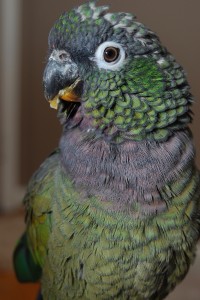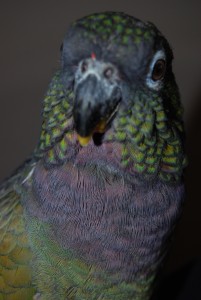Pets
My New Pet Training & More Blog Is At www.SoMuchPETential.com
Hi -Thank you so much for visiting.
I am so excited to share news that I have been working on for several months…but that I’ve been leading up to for a very long time. I’ve been studying behavior & training with positive reinforcement for many years, and am passionate about educating others so that they too can see the kind of success I have had with my pets.
My column in Hyde Park Living is exclusively about pet behavior. Now I am taking my passion to another level. In addition to my public relations work, I have just started a dog and bird training business. Next year I will be doing some educational programs for kids.
I’d love it if you’d visit my new website at http://SoMuchPETential.com to learn more. My pet training and fun blog has been moved to my new site. Here is a direct link.
Please join my Facebook community here – www.Facebook.com/SoMuchPETential
Lisa Desatnik
Thanksgiving Food Safety For Dogs
 Our Thanksgiving meal is my favorite of the whole year. Yes, much of that is because of the company I am surrounded by. But also, there is SO MUCH incredible food!
Our Thanksgiving meal is my favorite of the whole year. Yes, much of that is because of the company I am surrounded by. But also, there is SO MUCH incredible food!
I want to remind you, however, that not all Thanksgiving food is good for our dogs. Below are some things your dog should avoid:
Rich, fatty foods (turkey skins, gravy, etc,) as these can contribute to pancreatitis – an inflammation of the digestive gland that is painful and can be serious–requiring emergency veterinary assistance.
Cooked bones that can splinter
Baking strings from the turkey
Onions (used a lot in holiday stuffing) that can lead to canine anemia
Grapes and raisins whose toxins can cause kidney failure in pets
Chocolate is an absolute no-no as it can cause death
Caffeine and coffee are also toxic
Cake batter that has raw eggs
Bread dough that expands in your dog’s stomach and causes pain and bloat, which is fatal unless treated IMMEDIATELY
For tips on preventing dog behavior problems at Thanksgiving, please read my blog post at this link.
Training: On Solving Pet Behavior Problems
Preventing Dog Behavior Problems At Thanksgiving
NOTE: I have a new pet behavior blog located at http://www.SoMuchPETential.com/blog. Thanks!
Thanksgiving is quickly coming upon us. Oh to taste the turkey…stuffing…sweet potatoes…and pumpkin pie. I can hardly wait! So can Sam….and I bet your favorite pooch too.
So, let’s plan ahead. Sharing your meal with your guests AND your dog doesn’t necessarily have to be part of the holiday. The time to work on  teaching your dog new skills is now – not dinner time on November 22.
teaching your dog new skills is now – not dinner time on November 22.
Let’s put our applied behavior analysis thinking caps on and brainstorm. Remember, ABA is a systematic approach to solving behavior problems by changing the environment in which the behavior occurs.
We ask ourselves “What happened IMMEDIATELY prior to the behavior (antecedent) to set the ball rolling for the behavior?” and “What happened IMMEDIATELY after the behavior to reinforce it (consequence)?”
I’m going to simplify it and use for the sake of this column that the antecedent is ‘guests sitting at the dinner table with unbelievably savory food on dishes in front of them.’ The behavior is your dog bumping or scratching guests in their seats. (We’ll call this ‘begging.’) The consequence is that eventually your dog may get either attention or turkey or jackpot – BOTH!
How can we change the environment to set your dog up for success? If you know in advance that this is highly predictable behavior, you can use antecedent strategies to give less value to the begging. Some ideas? Satiate your dog BEFORE you sit down by feeding him in advance, redirect his attention by giving him a tasty steak bone to chew on or a foraging toy that will keep his attention for awhile, take him for a long walk or run prior to the meal to increase the value of resting behavior.
Another idea would be to teach your dog – in advance – an alternative behavior that will reap him the same or more reinforcing value than what he would get if he begged while also removing all positive consequences of begging. Remember, as his teacher, his ability to learn is dependent on your reliability (and EVERYONE in your household) to quickly reinforce the behavior you want to see – and every time he does the behavior in the beginning.
So, begin by teaching the alternative behavior (like sitting or laying down) and get it reliably on cue. Once on cue start teaching him to hold that behavior for longer durations before delivering reinforcement. Then, you can cue him to do the behavior before you sit down to a meal and reinforce it. At the same time, if he begs, you can simply push your plate in to the center of the table and turn your back to him while sitting. Practice. Practice Practice.
Dogs are pretty smart. If ‘you’ teach him that begging only gets people to turn away and push food aside but sitting or laying down gets a nifty treat, guess which choice he’ll make?
If you have a dog who is competing with our Sam for the title, World Champion Counter-Surfer, remember, often times the feat is carried out when your back is turned. (We know this from experience.) The simplest solution is eliminating access to the reinforcement that maintains the behavior. In other words, always be cognizant of being sure that tasty food is kept far enough from the counter edge that your dog can not reach it.
Stopping Parrot Biting Without Force
NOTE: I have a new pet behavior blog. Please visit http://www.SoMuchPETential.com/blog. Thanks!
Dreyfuss is a bird who – if I’d let her – would spend her entire day sitting next to me or on me, frequently with her head down for rubs. So how was it that this sweet girl (who actually may be a boy but I’ve never had her sexed) would lung at my bare arm, and even bite it, when I’d put my arm in front of her body before asking for a ‘step up’ from her inside cage perch?
My education in behavior has taught me that biting doesn’t just ‘occur’ in a vacuum, and that before that aggressive behavior happens, a bird behaves with nonaggressive body language (such as dilated eyes, feathers fluffed) to let me know my arm is not wanted in its space. If I get bitten it is because I did not pull my arm away when the bird dilated its eyes or fluffed its feathers, causing the bird to need to escalate its behavior.
Yes, I know that. But I had been watching Dreyfuss’ body language and I just couldn’t see it. One second her body language was telling me she was eager to step up and the next split second she’d lunge.
My turning point came the moment I had written an email to a trainer I know. In it, I told her Dreyfuss’ behavior was ‘unpredictable’. I hit send and then had a WOAH moment. Hold on here, Lisa. You know better than that. And you have the skills to solve this without the use of force and set both you and Dreyfuss up for success.
Applied behavior analysis is a systematic approach to solving behavior problems by changing the environment in which the behavior occurs. It involves looking at the very specific behavior (such as a bird biting or screaming) and the related environmental context that signals and reinforces it. We ask, “What happened *immediately* prior to the behavior (antecedent) to set the whole ball rolling?“ And, “What happened *immediately* after the behavior to reinforce it (consequence)?“
There you have it…the A (antecedent), B (behavior), and C (consequence)’s.
So, let’s look at the ABC’s of this situation.
A(antecedent): Lisa puts hand on cage door
B (behavior): Dreyfuss either rocks from foot to foot or with slight movement
C (consequence): Lisa opens cage door
A: Lisa moves arm to Dreyfuss saying ‘step up’
B: Dreyfuss lunges or bites
C: Lisa removes hand
Prediction: Dreyfuss will lunge or bite more to get Lisa to remove her hand
I know, this doesn’t make sense for a bird that, once is on me, could live there. But obviously there is something about my arm being put in front of her that she didn’t want to have happen. How do I know? Because her behavior of biting/lunging continued and got more frequent.
The thing about studying behavior is that I don’t need to know what Dreyfuss was thinking. I only need to know that the behavior had a function for  her in her environment and I can then modify the environment to modify the behavior. I like to think about it as teaching new skills.
her in her environment and I can then modify the environment to modify the behavior. I like to think about it as teaching new skills.
So, what did I do? Well, I DID NOT use punishment or any kind of force.
What I did do is create a plan that would set us both up for success.
I taught her the contingency that *when* I put my hand on her door, *if* she moves to the left side of the perch, *then* I will put my arm in front of the right side of the perch. And *if* she walks over to and steps up onto my arm, *then* she comes out for attention, seeds, and more.
The power of deciding whether to come toward my arm to come out – or not – was ALL up to HER. And guess what, given the choice, she not only decided to come to my arm every single time – she runs to it and jumps on board.
How great is that!
So, here is the new ABC:
A: Lisa puts hand on door
B: Dreyfuss moves to other side of perch
C: Lisa puts hand at opposite side of perch
2nd ABC:
A: Lisa puts hand at opposite side of perch
B: Dreyfuss moves to hand and steps up
C: Lisa takes Dreyfuss out for attention, seed and more
Taking her out of her cage is that simple now. The beauty of it is that I never used force or punishment. My ‘unpredictable’ bird when it comes to getting her out of her cage, now reliably runs with her feathers relaxed to my arm and as a result we both have confidence in that situation.


















